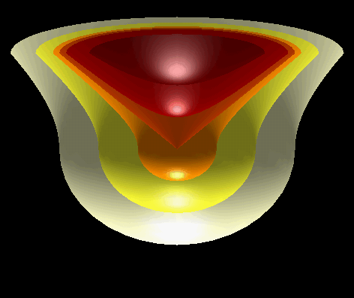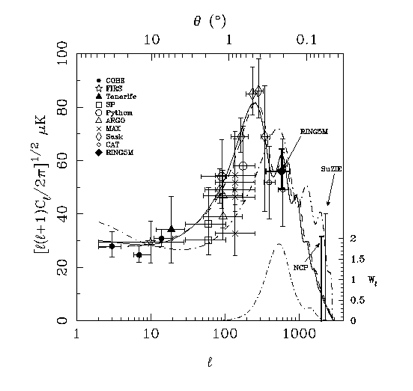Low density Universes and inflation
If the Universe is in fact of subcritical density, does this require abandoning inflation? If a flat Universe really is a "prediction" of inflation as once claimed, one would have to give up inflation.
There however exists an escape from this dilemma. Inflation within a single bubble can create a smooth Universe with a hyperbolic geometry, just as is required for a Universe of subcritical density.
Single bubble open inflation, based on ideas of S. Coleman and F. de Luccia and of J.R. Gott, III, in the early 1980s, was further developed in the mid-1990s by M. Bucher, A.S. Goldhaber, and N. Turok and later by M. Sasaki, T. Tanaka, and K. Yamamoto.
Inflation smooths the Universe by postulating an early epoch of extremely rapid expansion during which whatever irregularities may have existed prior to inflation are virtually erased. In ordinary inflation, as developed by Guth, Linde, Albrecht, and Steinhardt, this smoothing flattens the Universe as well, yielding a Universe of critical density. In ordinary inflation, a critical Universe could in principle be avoided by shortening the amount of inflation, but in that case the smoothness on large scales remains a mystery, causing inflation to lose most of its appeal.

The creation of a single bubble open Universe. The vertical direction indicates time and the horizontal directions are spatial. The value of the inflaton field is constant on the various slices and the colours indicate the cooling down of the Universe as one passes into the bubble interior. The bubble is expanding into the surrounding inflating spacetime stuck in the false vacuum. We live inside the bubble interior
In single bubble open inflation there are two epochs of inflation. In inflation the rate of expansion is controlled by a scalar field, known as the inflaton field. The inflaton field wants to roll down the hill to the bottom and as the field descends the rate of expansion of the Universe decreases, eventually ending the epoch of inflationary expansion. In open inflation the inflaton field at first remains stuck in a local minimum of the potential. While the field is stuck there, a first epoch of inflationary expansion takes place during which the Universe is smoothed. In fact during this epoch the symmetry of the spacetime is so large that no particular time direction is preferred over any other.
According to classical physics, once stuck in the local minimum the inflaton field never escapes. However, quantum mechanics allows the field to tunnel through the barrier. This tunneling occurs through the nucleation of a bubble that subsequently expands.
Subsequently, the bubble expands at the speed of light. It cannot have any velocity other than the speed of light, for else a preferred time direction would be required to exist. The surfaces on the bubble interior on which the scalar field is constant have a hyperbolic spatial geometry, and these are the surfaces that we inside the bubble later perceive as surfaces of constant cosmic time. As one passes inside the bubble, the interior continues to inflate, creating a Universe with a large curvature radius. Further inside the bubble the energy of the inflaton field is converted into ordinary matter and radiation, and the hyperbolic Universe continues to expand and cool down.
How can we test open inflation?

Microwave Anisotrophy as a function of angle. Plotted is the level of anisotropy as a function of angle and various measurements thereof. The curves indicate theoretical predictions for various models. The solid curve indicates a Universe of critical density whereas the dot-dash-dot-dash curve indicates a low density Universe. Note how the position of the first peak shifts to the right to smaller angular scales in the low density Universe
The best hope for testing open inflation derives from measuring the geometry of the Universe, which can be determined through observing the ripples in the cosmic microwave background radiation.
The 3K cosmic microwave background radiation emanates from an epoch approximately three hundred thousand years after the Big Bang, when the Universe was approximately one thousandth its present size. At this time the electrons, because of the cooling of the Universe, combined with protons and other nuclei to form neutral hydrogen and other elements. Because of this change in composition from a highly ionized plasma to a neutral gas, the formerly opaque Universe becomes virtually transparent. The non-uniformities in the microwave background provide a snapshot of the ripples at that time, which later developed into galaxies and the structure that we observe today.
Inflation in general, and open inflation on scales much shorter than the curvature scale, imprints essentially scale free fluctuations on the matter filling the Universe. At recombination, however, the physics at that time, believed to be well understood, introduces a preferred scale of known length on which the first acoustic oscillations of the plasma occur. This scale is of known physical size, and from its angle subtended in the sky today, we can determine the geometry of the universe.
